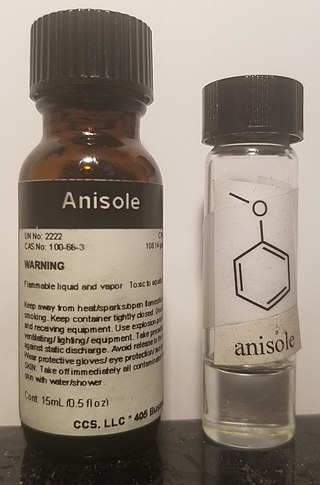Top Qs
Timeline
Chat
Perspective
Anisole
Organic compound (CH3OC6H5) also named methoxybenzene From Wikipedia, the free encyclopedia
Remove ads
Anisole, or methoxybenzene, is an organic compound with the formula CH3OC6H5. It is a colorless liquid with a smell reminiscent of anise seed, and in fact many of its derivatives are found in natural and artificial fragrances. The compound is mainly made synthetically and is a precursor to other synthetic compounds. Structurally, it is an ether (−O−) with a methyl (−CH3) and phenyl (−C6H5) group attached. Anisole is a standard reagent of both practical and pedagogical value.[2]
Remove ads
Reactivity
Summarize
Perspective
Anisole undergoes electrophilic aromatic substitution reaction at a faster speed than benzene, which in turn reacts more quickly than nitrobenzene. The methoxy group is an ortho/para directing group, which means that electrophilic substitution preferentially occurs at these three sites. The enhanced nucleophilicity of anisole vs. benzene reflects the influence of the methoxy group, which renders the ring more electron-rich. The methoxy group strongly affects the pi cloud of the ring as a mesomeric electron donor, more so than as an inductive electron withdrawing group despite the electronegativity of the oxygen. Stated more quantitatively, the Hammett constant for para-substitution of anisole is –0.27.
Illustrative of its nucleophilicity, anisole reacts with acetic anhydride to give 4-methoxyacetophenone:
- CH3OC6H5 + (CH3CO)2O → CH3OC6H4C(O)CH3 + CH3CO2H
Unlike most acetophenones, but reflecting the influence of the methoxy group, methoxyacetophenone undergoes a second acetylation. Many related reactions have been demonstrated. For example, phosphorus pentasulfide (P4S10) converts anisole to Lawesson's reagent, [(CH3OC6H4)PS2]2.[3]
Also indicating an electron-rich ring, anisole readily forms π-complexes with metal carbonyls, e.g. Cr(η6-anisole)(CO)3.[4]
The ether linkage is highly stable, but the methyl group can be removed with strong acids, such as hydroiodic acid or boron trichloride:[5]: 565–566
Birch reduction of anisole gives 1-methoxycyclohexa-1,4-diene.[6]
Remove ads
Synthesis
Anisole was first synthesized in 1841 by Auguste Cahours by barium anisate decarboxylation while heating p-anisic acid he made earlier from the anise essence with barium oxide:[7][8]
2 CH3OC6H4COOH + BaO → (CH3OC6H4COO)2Ba + H2O
(CH3OC6H4COO)2Ba → 2 CH3OC6H5 + BaCO3
It can be prepared by the Williamson ether synthesis from sodium phenoxide and dimethyl sulfate or methyl chloride:[9][5]
- 2 C6H5O− Na+ + (CH3O)2SO2 → 2 C6H5OCH3 + Na2SO4
Remove ads
Applications
Anisole is a precursor to perfumes, insect pheromones, and pharmaceuticals.[5] For example, synthetic anethole is prepared from anisole.
Safety
Anisole is relatively nontoxic with an LD50 of 3700 mg/kg in rats.[10] Its main hazard is its flammability.[10]
Popular culture
In the board game Scrabble, the word "anisole" is the 39th-most-likely word (out of over 25,000 possibilities) for a "bingo"/"bonus", i.e. the deployment of all seven letters in one's own hand simultaneously.[11]
See also
References
External links
Wikiwand - on
Seamless Wikipedia browsing. On steroids.
Remove ads






